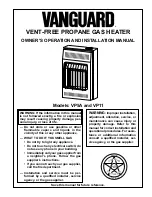
www.desatech.com
116412-01C
1. Determine the volume of the space (length x
width x height).
Length x Width x Height = _________cu. ft.
(volume of space)
Example:
Space size 20 ft. (length) x 16 ft.
(width) x 8 ft. (ceiling height) = 2560 cu. ft.
(volume of space)
If additional ventilation to adjoining room is sup-
plied with grills or openings, add the volume of
these rooms to the total volume of the space.
2. Multiply the space volume by 20 to determine
the maximum Btu/Hr the space can support.
____________(volume of space) x 20 =
(Maximum Btu/Hr the space can support)
Example:
2560 cu. ft. (volume of space) x
20 = 51,200 (maximum Btu/Hr the space can
support)
3. Add the Btu/Hr of all fuel burning appliances
in the space.
Vent-free appliance
_________Btu/Hr
Gas water appliance*
_________Btu/Hr
Gas furnace
_________Btu/Hr
Vented gas appliance
_________Btu/Hr
Gas fireplace logs
_________Btu/Hr
Other gas appliances* +_________Btu/Hr
Total
=_________Btu/Hr
* Do not include direct-vent gas appliances.
Direct-vent draws combustion air from the
outdoors and vents to the outdoors.
Example:
Gas water appliance
_________Btu/Hr
Vent-free appliance
+_________Btu/Hr
Total
=_________Btu/Hr
4. Compare the maximum Btu/Hr the space can
support with the actual amount of Btu/Hr used.
___________ Btu/Hr (maximum the space
can support)
____________Btu/Hr (actual amount of
Btu/Hr used)
Example:
51,200 Btu/Hr (maximum the
space can support)
73,000 Btu/Hr (actual amount of
Btu/Hr used)
AIR FOR COMBUSTION
AND VENTILATION
Continued
The space in the previous example is a confined
space because the actual Btu/Hr used is more than
the maximum Btu/Hr the space can support. You
must provide additional fresh air. Your options
are as follows:
A. Rework worksheet, adding the space of an
adjoining room. If the extra space provides an
unconfined space, remove door to adjoining
room or add ventilation grills between rooms.
See
Ventilation Air From Inside Building
.
B. Vent room directly to the outdoors. See
Ven-
tilation Air From Outdoors,
page 8.
C. Install a lower Btu/Hr appliance, if lower
Btu/Hr size makes room unconfined.
If the actual Btu/Hr used is less than the
maximum Btu/Hr the space can support, the
space is an unconfined space. You will need
no additional fresh air ventilation.
WARNING: If the area in which
the appliance may be operated
is smaller than that defined as
an unconfined space or if the
building is of unusually tight
construction, provide adequate
combustion and ventilation air
by one of the methods described
in the
National Fuel Gas Code,
ANSI Z223.1/NFPA 54 Section 5.3
or applicable local codes.
VENTILATION AIR
Ventilation Air From Inside Building
This fresh air would come from an adjoining un-
confined space. When ventilating to an adjoining
unconfined space, you must provide two perma-
nent openings: one within 12" of the ceiling and
one within 12" of the floor on the wall connecting
the two spaces (see options 1 and 2, Figure 2 on
page 8). You can also remove door into adjoining
room (see option 3, Figure 2). Follow the
National
Fuel Gas Code, ANSI Z223.1/NFPA 54, Section
5.3, Air for Combustion and Ventilation
for re-
quired size of ventilation grills or ducts.
40,000
33,000
73,000








































